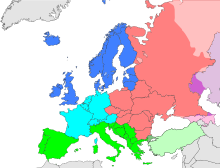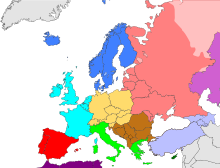Regional breakdown
Regional breakdowns are geographical subdivisions of large areas, for example for organizational or statistical purposes.
The most common purpose of regional structures is to create a geographical organizational or administrative structure - if necessary also hierarchical . National divisions have mostly grown historically and are often resistant to change. For the purpose of analysis or comparison, given state structures are often used, but sometimes in a different composition, adapted to the pursued goal. When determining the boundaries, one likes to orientate oneself on natural conditions (mountains, mountains, rivers, lakes), man-made structures (roads, canals, reservoirs) and cultural conditions (population structure, languages, similarities in culture and history), but especially on existing state and administrative borders.
For city or municipality areas, the classification made for statistical purposes is called small-scale breakdown .
Subdivision of a state
Each state must subdivide its territory for administration. In earlier times with frequent changes of ownership, the structures found were often taken over, so a state was built up from a number of provinces of different sizes.
In France , traditions were broken in the French Revolution in 1789 and the 39 provinces that had grown over time and were of different sizes were replaced by départements of almost the same size . This corresponded to the will for standardization and equal treatment. Today's 101 departments are grouped into 27 regions.
In Switzerland , different classifications are used in parallel (see list of regions in Switzerland ):
- 7 major regions according to the Federal Statistical Office
- 11 regions, geographically or geologically shaped
- 4 language areas
Subdivision of large areas through aggregation
Geographic classes can be defined based on existing class elements (states, districts, districts). The boundary conditions for this are:
- Similarity of class elements according to defined characteristics - often the geographic location
- Neighborhood of class elements
- Similarly large number of class elements in each class
- Acceptance of the classification with regard to the application
The classes found are often named after cardinal points.
In addition to such geographic classes, content classes can also be created (example: industrialized countries). However, these do not define a regional breakdown.
Example subdivision of the continents by the UNSD
The United Nations Statistic Division ( UNSD ) groups countries and areas into regions. These summaries are used for statistical purposes, but are also used in other contexts.
The divisions of the continents Asia and Africa shown in Wikipedia follow the UNSD subdivision; for the continents of Europe and Oceania the UNSD subdivisions are mentioned.
Classification according to cultural aspects
From the humanities side, too, especially from ethnology (earlier ethnology), there were and still are attempts to subdivide the continents. The concept of the cultural area - a large settlement area whose inhabitants can be assigned to a similar culture - is used less today. A similar term that is more commonly used today is the cultural area .
The cultural part of the earth can be viewed as a combination of humanities and geographical aspects , which not only takes cultural features into account but also natural spaces .
A distinction is usually made between 10 cultivated parts of the earth:
- Anglo America : Canada and United States
- Latin America : all countries from Mexico in the north to Chile in the south
- (Western) Europe
- Eastern Europe / Russia
- Orient : North Africa , Arabian Peninsula , some Gulf States , their neighbors, and the Islamic part of Central Asia
- Africa south of the Sahara
- South Asia : India , Nepal , parts of Pakistan and neighboring countries
- Southeast Asia : Rear India , Malaysia and Indonesia
- East Asia : China , Mongolia , Japan and Korea
- Oceania including Australia
Different subdivisions of Europe



If a continent is broken down by combining its states, the results may differ. To illustrate this, three different proposals for a regional division of Europe are placed side by side.
The topographical division of Europe (left), as proposed by the Standing Committee on Geographical Names , dividing Europe into six regions : Northern Europe, Western Europe, Central Europe, Eastern Europe, Southeastern Europe and Southern Europe. There are two variants: one is based on national borders and the other on "cultural-spatial criteria".
The structure of the UNSD (top right), which divides Europe into four regions: Northern Europe, Western Europe, Eastern Europe and Southern Europe.
The structure in the US , The World Factbook published by the CIA (bottom right), which divides Europe into seven regions: Northern Europe, Western Europe, Central Europe, Eastern Europe, Southeastern Europe, Southern Europe and Southwestern Europe.
Uniform hierarchical structure
For purposes of comparison, reference areas that are uniformly defined are required for the calculation of social indicators . For this reason, statistical data of a state are often collected in relation to the administrative boundaries applicable in that state. If a supranational organization such as the EU needs statistics spanning all states, which provide the figures not only at the level of the member states, but also in a smaller resolution, the reference areas must be systematised uniformly.
Example EU area and NUTS
The EU statistical authority Eurostat has brought together the different hierarchical administrative structures of the member states with the “System of Territorial Units for Statistics” ( NUTS ). At the top level are the states, in further stages the administrative subdivisions already in place in the individual states are mostly used in order to obtain uniform subdivisions across Europe. Four regional hierarchical levels and two local / communal levels are taken into account.
Outline with geographic grid
The use of grid cells has become more widespread in recent years, particularly for displaying maps. A grid or measuring grid with a defined mesh size is placed over the area under consideration . The mesh size is arbitrary, often 10 m, 100 m, 125 m, 1 km or 10 km are chosen. The cell size determined in this way must match the question and the data available. Cells with a size of 100 m × 100 m are called hectare cells . An example of a map with grid cells are the population grids generated by Eurostat. The Austrian statistical office Statistics Austria offers maps with grid sizes from 125 m to 10 km.
See also
- Subnational administrative units , list of national administrative divisions by state
Individual evidence
- ^ Composition of macro geographical (continental) regions, geographical sub-regions, and selected economic and other groupings . United Nations Statistics Department. Retrieved March 1, 2013.
- ↑ Population grids . Eurostat. Retrieved March 2, 2013.
- ↑ Regional statistical subdivisions according to geographical grids . Statistics Austria. Retrieved on March 2, 2013. ( Page no longer available , search in web archives ) Info: The link was automatically marked as defective. Please check the link according to the instructions and then remove this notice.
